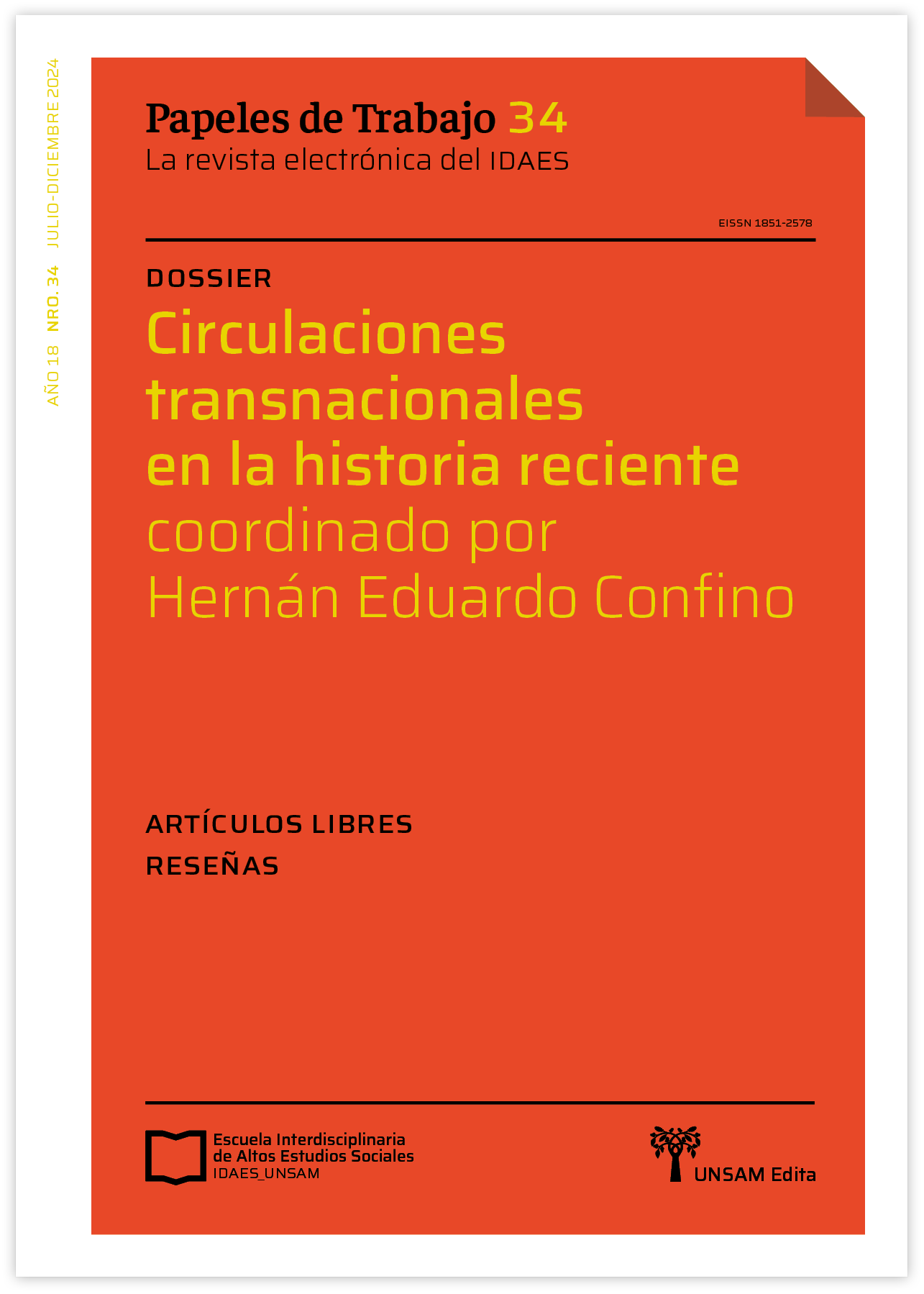Entre homogeneización y pluralidad
El rol de la novela gráfica en las memorias de las violencias contra estudiantes en la historia reciente de México y Estados Unidos
Keywords:
Globalization, Cultural Memory, Student repression, Hybrid identities, Cultural homogenizationAbstract
This article explores the role of graphic novels in social memory studies through a comparative analysis of Grito de Victoria by Augusto Mora and Kent State: Four Dead in Ohio by Derf Backderf, both produced in the second decade of the 21st century. The study focuses on how these graphic novels address the memories of student repression within a globalized context. Using an exploratory approach and a documentary methodology, the research combines bibliographic and iconographic analysis with interviews with the authors to provide an analytic view of graphic narratives. The article is structured into five interrelated sections: (1) a descriptive synthesis of the repression memories in both novels; (2) a contextualization of the graphic novel medium within the globalization of communication; (3) an analysis of how local interpretations are integrated into an international framework; (4) a discussion on resistance to cultural homogenization; and (5) a final reflection on how graphic novels address repression memories in a transnational context. This approach helps to understand how graphic novels contribute to the representation and critical reflection of sociopolitical experiences in an interconnected world.
References
Alexander, Jeffrey (2006), The Civil Sphere, New York: Oxford University Press
Assmann, Aleida, y Sebastian Conrad (eds.) (2010). Memory in a Global Age. Discourses, Practices and Trajectories, New York: Palgrave Macmillan
Britannica, Encyclopædia. (2021). Black Lives Matter (BLM). Britannica Academic. Consultado el 25 de julio de 2024. en https://academic-eb-com.pbidi.unam.mx:2443/levels/collegiate/article/Black-Lives-Matter/632854
Bryson, Norman (1986). Vision and Painting. London: Macmillan.
Bucher, Katherine, y Lee Manning (2004). “Bringing Graphic Novels into a School's Curriculum”. The Clearing House; Nov/Dec; 78, 2 : 67-72
Castells, Manuel (2000). La era de la información. Economía, sociedad y cultura. la sociedad red (vol. I). Madrid: Alianza Editorial.
Castells, Manuel (2001). La era de la información. Economía, sociedad y cultura: el poder de la identidad (vol. II). México: S. XXI. Ed.
Cohen, David (2006). Globalization and Its Enemies. Cambridge: MIT. Press.
Deffis, Emilia (2020). “Voces dibujadas: a la búsqueda de la memoria histórica mexicana: Entrevista a Mora” Revista Digital Universitaria, 21: 5, 1-21
Dussel, Ines, y Daniela Gutierrez (2006). “Introducción”. En Dussel, I. & Gutierrez, D. (Eds) Educar la mirada: políticas y pedagogías de la imagen. Buenos Aires : Manantial : OSDE.
Erll, Astrid (2011). Travelling Memory, Parallax, 17:4, 4-18
Espinosa Lucas, Emmanuel (2021). La aclimatación de la NG en México (1994-2019): Un género entre la revista independiente, la autopublicación y la edición de lujo, Tesis de Doctorado en Ciencias Sociales, ICSH, de la Universidad Autónoma del Estado de Hidalgo.
Estrada Saavedra, Marco (2014). Sistema de protesta: política, medios y el #YoSoy132. Sociológica (México), 29(82), 83-123.
Grand, Camille (2007) “El siglo XX: el periodo de ‘distensión’”. En Larousse, enciclopedia QUOD. Lima: Larousse ed.
Hall, Stuart (1996). “Who needs identity?” En Hall, S & P. Du Gay (eds). Questions of cultural identity (15-30). Londres: Sage.
Hartog, François (2012). Régimes d’historicité. Paris: Seuil.
Jelin, Elizabeth (2018). “Emprendedores de memoria” en Vinyes, R. (coord.). Diccionario de la memoria colectiva. Barcelona: Gedisa : 161-162
Lent, John (2010). “Manga in East Asia”. En T. Johnson-Woods (Ed.), Manga: An Anthology of Global and Cultural Perspectives (297–314). New York: Continuum.
Lent, John (Ed.) (1999) Pulp Demons: International Dimensions of the Post-War Anti-Comics Campaign, NJ: Fairleigh Dickinson ed.
Lent, John (Ed.) (2005). Cartooning in Latin America. Nj: Hampton Press
Mazur, Dan, y Alexander Danner (2014) Comics: A Global History, 1968 to the Present, Londres: Thames & Hudson.
Merino, Ana (2017). Comics in Latin America. En The Routledge Companion to Comics (pp. 70-78). Routledge.
McCloud, Steve (1994). Understanding comics. The invisible art. New York: Harper Collins ed.
Paraleerenlibertad. (23 de agosto de 2017). MORA "Grito de victoria" [Archivo de Vídeo]. https://www.youtube.com/watch?v=0ujgPZ0tth8&t=729s
Pons, Álvaro (2018). “Tebeos raros. Poéticas y nuevos caminos de la historieta”. Claves de razón práctica, # 256: 36-45
Puigdevall, Carolina. (2018). “Cómic y arte, un espacio de libertad”. Claves de razón práctica, # 256: 46-51
Robertson, Roland (1992). Globalization: Social Theory and Global Culture. Londres: SAGE.
Santamaría Colmenero, Sara (2018) “Memoria cultural”. En Vinyes, R. (coord.). Diccionario de la memoria colectiva (283-284). Barcelona: Gedisa.
Society of Illustrators (21 de abril de 2021). Kent State with Backderf [Archivo de Vídeo]. https://www.youtube.com/watch?v=VwjVlODLXbc
Stein, Daniel; Christina Meyer, y Micha Edlich (2011). Introduction: American Comic Books and Graphic Novels. Amerikastudien/American Studies, 501-529.
Teer-Tomaselli, Ruth, y Lauren Dyll-Myklebust (2012). “Finding Yourself in the Past, the Present, the Local, and the Global Potentialities of Mediated Cosmopolitanism as a Research Methodology”. En Ingrid Volkmer (ed). The Handbook of Global Media Research (451-469). Londres: Blackwell Publishing.
Urry, John (2003). Global Complexity, Cambridge: Polity
Van Dijk, Jan (2006). The Network Society: Social Aspects of New Media, London: SAGE
Wieviorka, Michel (Fondation Maison des sciences de l'homme-FMSH). (12 de diciembre de 2007). Réflexion sur la mondialisation, en Sociologie du conflit. [Archivo de Vídeo]. Canal-U. https://doi.org/10.60527/c762-s651.
Fuentes primarias
Backderf, Derf. (2020). Kent State. New York: Abrams ComicsArt.
Mora, Augusto. (2013). Grito de Victoria. Ciudad de México: MQ Comics.








